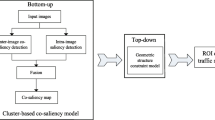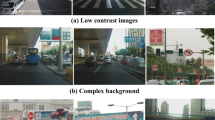Abstract
Traffic signs are made in many different shapes and colors that normally stand out from their environment for the purpose of enhancing their visibility to drivers. In most previous research, the methods for detecting traffic signs used shape and color information. However, the shape and color information of traffic signs is sensitive to features of the surroundings, such as the viewpoint and changes in the brightness or background, consequently making such information less reliable in terms of accuracy. To solve the problem, this paper presents a method for detecting traffic signs that is invariant under various environmental changes such as those in the appearance and illumination of traffic scenes. This method uses a saliency model to capture those features of traffic signs that are invariant to shading and shadow. Next, a traffic sign color model is used to extract the color features invariant under illumination changes. By using these models, the presented method can identify all possible shapes and colors for similarly representing the traffic signs. Finally, the traffic signs are detected through a so-called object verification process in which each traffic sign can be recognized by finding a region of overlap between two selected candidate regions. Automatic detection of traffic signs by implementing the presented approach has been examined with traffic scenes of some roads. In particular, the detection rate for traffic signs was 92%, while the processing time per frame was 0.27s.
Similar content being viewed by others
References
Armingol, J. N., Escalera, A. de la, Hilario, C., Collado, J. M., Carrasco, J. P., Flores, M. J., Pastor, J. M. and Rodriguez, F. J. (2007). IVVI: Intelligent vehicle based on visual information. Robotic and Autonomous Systems 55,12, 904–916.
Arrospide, J. and Salgado, L. (2012). On-road visual tracking using markov chain monete carlo particle filtering with metropolis sampling. Int. J. Automative Tehnology 13,6, 955–961.
Arroyo, S. L., Femandez, A. S., Bascon, S. M., Jimenez, P. G. and Rodriguez, F. J. A. (2007). Road sing recognition using spatial dimension reduction methods based on PCA and SVMs, LNCS, 4507, 725–732.
Borji, A., Ahmadabadi, M. N. and Araabi, B. N. (2010) Online learning of task-driven object-based visual attention control. Image and Vision Computing 28,7, 1130–1145.
Cherng, S., Fand, C. Y., Chen, C. P. and Chen, S. W. (2009). Critical motion detection of nearby moving vehicles in a vision-based driver-assistance system. IEEE Trans. ITS 10,1, 70–82.
Ebner, M. (2004). A parallel algorithm for color constancy. J. Parallel and Distributed Computer, 64, 79–88.
Escalera, de la, Armingol, J. M. and Mata, M. (2003). Traffic sign recognition and analysis for intelligent vehicles. Image and Vision Computing, 21, 247–258.
Escalera, de la, Armingol, J. M., Pator, J. M. and Rodriguez, F. J. (2004). Visual sign information extraction and identification by deformable models for intelligent vehicles. IEEE Trans. ITS 5,2, 57–68.
Estevez, L. and Kehtarnavaz, N. (1996). A real-time histographic approach to road sign recognition. IEEE Symp. Image Analysis and Interpretation, 95–100.
Fang, C. Y., Fuh, C. S., Chen, S. W. and Yen, P. S. (2003a). A road sign recognition system based on dynamic visual model. IEEE Conf. CVPR, 750–755.
Fang, C. Y., Chen, S. W. and Fuh, C. S. (2003b). Road-sign detection and tracking. IEEE Trans. VT, 52, 1329–1341.
Fleyeh, H. (2006). Shadow and highlight invariant colour segmentation algorithm for traffic signs. IEEE Conf. Cybernetics and Intelligent Systems, 1–7.
Fleyeh, H., Dougherth, M., Aenugula, D. and Baddam, S. (2007). Invariant road sign recognition with fuzzy ARTMAP and Zernike moments. Proc. IEEE IVS, 31–36.
Fleyeh, H. and Zhao, P. (2008). A contour-based separation of vertically attached traffic signs. IEEE Proc. IE, 1811–1816.
Fu, M. Y. and Huang, Y. S. (2010). A survey of traffic sign recognition. Proc. Int. Conf. Wavelet Analysis and Pattern Recognition, 119–124.
Gao, X. W., Podladchikova, L., Shaposhnikov, D., Hong, K. and Shevtsova, N. (2006). Recognition of traffic signs based on their colour and shape features extracted using human vision models. J. Visual Comm. & Image Repres., 17, 6.
Gonzalez, R. C., Woods, R. E. and Eddins, S. L. (2009). Digital Image Processing Using MATLAB. Sec. edn. Gatesmark Publishing, USA. 75–685.
Harris, C. and Stephens, M. (1988). A combined corner and edge detector. Proc. Alvey Vision, 147–152.
Itti, L., Koch, C. and Niebur, E. (1998). A model of saliency-based visual attention for rapid scene analysis. IEEE Trans. PAMI. 20,11, 1254–1259.
Jung, H. G., Lee, Y. H., Kang, H. J. and Kim, J. (2009). Semsor fuction-based lane detection for LKS+ACC system. Int. J. Automative Tehnology 10,2, 219–228.
Kehtarnavaz, N., Griswold, N. C. and Kang, D. S. (1993). Stop-sign recognition based on colour-shape processing. Machine Vision and Applications, 6, 206–208.
Kim, J. B. (2008). Real-time moving object recognition and tracking using the wavelet-based neural network and invariant moments. J. IEEK, 45SP,4, 304–315.
Kim, S. Y., Choi, H. C., Won, W. J. and Oh, S. Y. (2009). Driving evironmont assessment using fusion of in-and out-of-vehicle vision systems. Int. J. Automative Tehnology 10,1, 103–113.
Kim, M. H. and Son, J. (2011). On-road asstssment of invehicle driving workload for older drivers: design guidelines for intelligent vehicles. Int. J. Automative Tehnology 12,2, 265–272.
Koch, C. and Ullman, S. (1985). Shifts in selective visual attention: Towards the underlying neural circuitry. Human Neurobiology, 4, 219–227.
Kuo, Y. C., Pai, N. S. and Li, Y. F. (2011). Vision-based vehicle detection for a driver assistance system. Computer and Mathematics with Applications 61,8, 2096–2100.
Lee, B. and Kim, G. (2012). Robust detection of preceding vehicles in crowded traffic conditions. Int. J. Automative Tehnology 13,4, 671–678.
Li, R. Y. and Liu, X. (2010). Robust class similarity measure for traffic sign recognition. IEEE Trans. ITS 11,4, 846–855.
Meur, L., Callet, P. L., Barba, D., Thoreau, D. and Francois, E. (2004). From low level perception to high level perception, a coherent approach for visual attention modeling. Proc. SPIE Human Vision and Electronic Imaging, 5292, 284–295.
Ohta, Y. I., Kanade, T. and Sakai, T. (1980). Color information for region segmentation. Computer Graphics and Image Processing, 13, 222–241.
Oliva, A., Torralba, A., Castelhano, M. S. and Henderson, J. M. (2003). Top-down control of visual attention in object detection. Proc. ICIP, 253–256.
Paclik, P. and Novovicova, J. (2000). Road sign classification without color information. Proc. Advanced School of Imaging and Computing, 1–7.
Piccioli, G., Micheli, E. D., Parodi, P. and Campani, M. (1996). A robust method for sign detection and recognition. J. Image and Vision Computing, 14, 209–223.
Ruta, A., Li, Y. and Liu, X. (2010). Real-time traffic sign recognition from video by class-specific discriminative features. Pattern Recognition, 43, 416–430.
Schiekel, C. (1999). A fast traffic sign recognition algorithm for gray value images. LNCS, 1689, 588–595.
Sun, Y. and Fisher, R. (2003). Object-based visual attention for computer vision. Artificial Intelligence, 146, 77–123.
Treue, S. (2003). Visual attention: the where, what, how and why of saliency. Current Opining in Neurobiology 13,4, 428–432.
Tsai, L. W., Hsieh, J. W., Chuang, C. H., Tseng, Y. J., Fan, K. C. and Lee, C. C. (2008). Road sign detection using eigencolour. IET Computer Vision 2,3, 164–177.
Van de Weijer, J., Gevers, T. and Gijsenij, A. (2007). Edgebased color constancy. IEEE Trans. Image Processing 16,9, 2207–2214.
Van de Weijer, J., Gevers, T. and Geusebroek, J. M. (2005). Edge and corner detection by photometric quasiinvariants. IEEE Trans. PAMI 27,4, 625–630.
Van de Weijer, J., Gevers, T. and Bagdamov, A. D. (2006). Boosting color saliency in image feature detection. IEEE Trans. PAMI 28,1, 150–156.
Vitabile, S. and Sorbello, F. (1998). Pictogram road sign detection and understanding in outdoor scenes. Proc. SPIE, 3364, 359–370.
Author information
Authors and Affiliations
Corresponding author
Rights and permissions
About this article
Cite this article
Kim, J.B. Detection of traffic signs based on eigen-color model and saliency model in driver assistance systems. Int.J Automot. Technol. 14, 429–439 (2013). https://doi.org/10.1007/s12239-013-0047-6
Received:
Revised:
Accepted:
Published:
Issue Date:
DOI: https://doi.org/10.1007/s12239-013-0047-6




